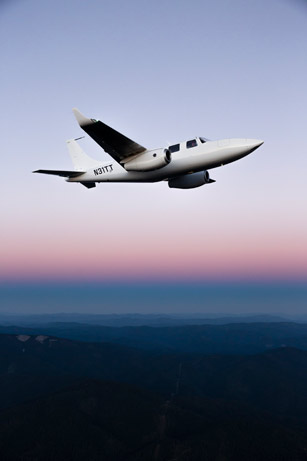
White stripes on the centerline of Runway 2 at Idaho’s Coeur d’Alene Airport-Pappy Boyington Field pass by in a rush as the Aerostar Jet prototype blasts from a standing start to its 95-knot rotation speed in just seven seconds and 1,000 feet of ground roll. As the twin Pratt & Whitney PW615F engines race forward, gulping more air, they produce even more power.
I pitch up to 15 degrees and hastily raise the landing gear as the airspeed blows through 130 knots. Aerostar Aircraft Vice President Jim Christy retracts the flaps from their 20-degree takeoff setting and the airspeed jumps to 180 knots. With two people on board, 200 gallons of fuel, and each of the FADEC engines pushing out 1,460 pounds of thrust, our power-to-weight ratio is a sprightly 0.5:1, or a half-pound of thrust for each pound
of weight. (When fully loaded, the Aerostar Jet has a thrust-to-weight ratio of 0.42:1 compared to a Cessna Citation Mustang at 0.337:1.)
Even though the air temperature is 85 degrees Fahrenheit (26 degrees above standard), the airplane is climbing 4,000 feet per minute at 200 KIAS.
“Even after many years and thousands of hours flying high-performance piston Aerostars, I was still taken by surprise at the jet’s initial acceleration, and how long that acceleration lasts,” said Christy, whose company owns the Aerostar type certificate and produced this jet airplane—the culmination of designer Ted R. Smith’s original vision for the Aerostar—in 2010. “It continues to amaze me.”
On another flight with three aboard, full fuel, and photo gear, we are about 200 pounds below the Aerostar Jet’s maximum gross weight of 6,850 pounds and hand-fly all the way to its non-RVSM ceiling of 28,000 feet. There, at maximum cruise power, the airplane is traveling 355 knots true airspeed while burning 55 gph per side. At an economy cruise setting we slow to 330 KTAS at 40 gph per side with an outside air temperature 28 degrees F over standard. With a 5.5-psi pressurization system, the cabin altitude is 9,500 feet.
Aerostar Aircraft designer Steve Speer estimates the jet will reach a maximum 403 KTAS at FL320, and fuel flow will fall to 35 gph per side at FL410. With a full-fuel payload of 652 pounds, the Aerostar Jet can fly 1,000 nm with IFR reserves.
“Aerostar has always been the performance leader in piston aircraft and we want to extend that legacy in light jets,” Speer said. “That’s the history of the Aerostar—and its future.”
Speed machine
Legendary designer Smith created the original Aerostar in the mid-1960s as a no-compromises personal speed machine. It set multiple speed records for piston aircraft, and the pressurized and turbocharged versions have long laid claim to the title of fastest FAA-certified piston twin.
Aerostar production began in 1967 and the first model flew the next year. Ownership of the company changed many times over the years, but Smith, the charismatic and hard-charging lead engineer on the World War II Douglas A–26 Invader and designer of the Aero Commander and Jet Commander, believed so much in the Aerostar that he and a group of investors repurchased the company by taking it private in 1972. He always envisioned a family of aircraft with a jet version at the pinnacle, but there were no suitably small and efficient fanjet engines when Smith passed away in 1976.
Piper Aircraft bought the rights to the Aerostar in 1978, and production eventually ceased in 1984. Christy and Speer, both former employees at the Ted R. Smith Aircraft Company, had long been involved in Aerostar upgrades and modifications in their own business ventures, and they bought the rights to the airplane from Piper in 1991. Roughly 1,000 Aerostars had been produced over the years, and about 700 are still registered and flying. “We bought the type certificate because we wanted to support the existing fleet,” Speer said. “And we wanted to produce the jet.”
The company drew up several designs, including a stretched version with a T-tail and aft-fuselage-mounted engines. They explored many options but finally concluded Smith’s original plan for wing-mounted engines was best. The engines could take in undisturbed air; there was no need to alter the tail, less chance of ingesting ice and change to the aircraft’s center of gravity was minimal.
In 2005, Pratt & Whitney certified the PW615F engine for the Cessna Mustang, and finally, there was a modern engine that could be adapted for the Aerostar. Speer began detailed design work in 2006, and the prototype first flew on July 27, 2010.
Cabin entry is standard through the pilot-side clamshell door. Engine start is simple and quick. With the electrical system fully charged at 28 volts, move the start switch to the On position and when N2 reaches 12 percent, slide the power lever forward to idle. ITT climbs to 615 degrees and then falls, and the process is repeated with the second engine.
With the door seals and pressurization set, we start the air conditioner and taxi to Runway 2. Thanks to the full-authority digital engine controls (FADEC), idle thrust is minimal, and there’s no tendency for the airplane to creep forward.
Steering is an odd dance familiar only to Aerostar pilots. Tap a rocker switch on the center console left and right to activate the electro-hydraulic nosewheel steering mechanism, and dance on the brakes. With flaps set to 20 degrees for takeoff, line up with the runway and hold the brakes. Then move the power levers forward to the Takeoff detent and be prepared to go upward like an express elevator.
The engines sound like oversized vacuums during the four seconds they take to spool up into a shrill whistle. The 90-knot rotation speed comes seven seconds after brake release, and a firm pull on the yoke has the airplane off the ground and climbing at nine seconds. The gear retraction seems to have more clunks and groans than a piston Aerostar, but that’s only because the far quieter cabin allows such sounds to be heard.
Control harmony is beautifully balanced, yet pressures vary surprisingly little between slow flight and cruise. Handling qualities are crisp and harmonious all the way up to FL280. In level flight, adding engine power results in a slight pitch up, and decreasing engine power lowers the nose, so the yoke-mounted elevator trim switch gets frequent use. (There is no manual trim.)
In descent, 190 KIAS and idle power results in an altitude loss of 2,000 fpm. The jet doesn’t have speed brakes and Christy says they aren’t needed. “These FADEC engines have an idle speed of about 48 percent N1, far lower than earlier jets,” he said. “They produce relatively little idle thrust, so speed brakes aren’t required for descent or landing.”
We join up with a Cessna 210 Centurion for an aerial photography session at 7,000 feet msl near Lake Pend Oreille, and the Aerostar feels solid and obedient at 140 KIAS. This is the first time I’ve flown a jet of any kind in formation, and I call for 10 degrees of flaps at first, then raise them completely a few minutes later when it becomes obvious they aren’t necessary for maneuvering, even at these relatively low speeds.
Approaching Aerostar Aircraft’s home base in Coeur d’Alene, I hand over the controls to Christy. He lowers the flaps 20 degrees at 170 KIAS, enters the right downwind at 1,200 feet agl, and drops the gear at midfield and 150 KIAS. Sixty percent N1 keeps us level at 120 KIAS on downwind and he reduces power to just above idle on base. Full flaps slow the airplane to 110 KIAS on final and 100 over the fence.
There is no roundout and Christy waits almost until the airplane is ground effect to wipe off the power and touch down in a relatively flat, four-degree nose-up attitude. This approach and landing method are virtually identical to what he recommends for piston Aerostars, but he carries about 10 knots more speed in the jet and goes to idle a few seconds sooner. The jet touches down at 80 KIAS and stops after a ground roll of 2,000 feet with moderate braking.
Christy says he’s still refining his technique in the jet and believes he could safely reduce approach and landing speeds by five knots or more. Christy said he and Speer are certain that designer Smith—their famously impatient former boss—would enthusiastically endorse their efforts to make his original vision for the Aerostar a reality.
“I’m absolutely certain he’d love this airplane,” Christy said. “His only question to us would be, What took you so long?
Email [email protected]
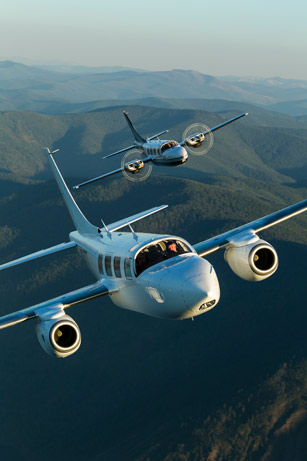
Since then it has logged about 200 hours of flight time and been evaluated by several professional test pilots. Speer and Christy have begun looking for partners to certify the jet and put the six-seat airplane into production. Speer estimates it will cost about $5 million to complete certification, a figure that seems unrealistically low in today’s regulatory environment, but one Speer says is on target for adding a new propulsion system to an existing design.
The company won’t say how close it is to finding an investor or a production partner, and it continues to chip away at certification requirements as resources allow.
With FAA certification, the company could offer jet upgrades to existing Aerostars for about $1.7 million. Factory- new aircraft could be produced for about $2.6 million, although starting a production line is a multiyear project that will require major new investments.
“We’re convinced this airplane can be FAA certified as is, or with only minor modifications,” Christy said. “This isn’t a proof of concept airplane. It’s a fully conforming flight test vehicle that can be used for certification.”
The airframe of what would become the first Aerostar Jet, N31TT, was originally built in 1977 as a pressurized, turbocharged 601P. It had logged about 1,600 hours total time as a piston twin, and Aerostar Aircraft previously used it as a testbed for a gross weight increase—so it’s a workhorse, not a show horse. The wings are bare aluminum, the fuselage is an unadorned white, and the steam-gauge instrument panel is mostly original with the exception of the engine controls and instrumentation.
The airframe dimensions are unchanged with the obvious exception of the jet engines, which are a total 400 pounds lighter than the piston models they replace—and an additional fuselage fuel tank and enlarged wing fuel tanks, which enable the airplane to carry a total of 309 gallons (up from 165 gallons). It’s also got additional structure on the inboard portions of the wings to support the jet engines.
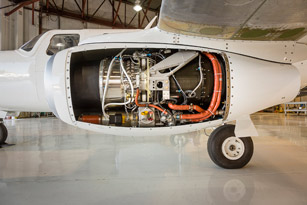
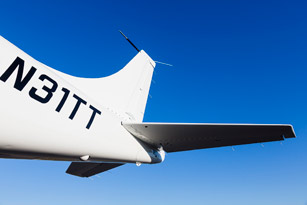


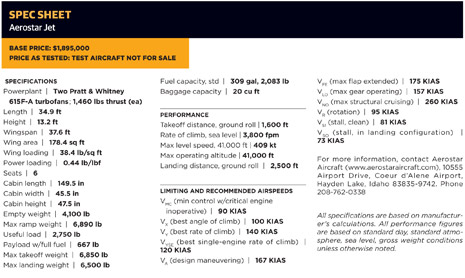

Aircraft designer Ted R. Smithhad a vision
Ted R. Smith let his brash aircraft designs speak for themselves. Quiet and collaborative, he had a central role in a prolific string of military and civilian aircraft that helped create modern business aviation. Born in California in 1906, he graduated from Oakland Technical High School in 1925 and the Boeing School of Aeronautics in 1929.
His first design was a tube-and-fabric glider, and Smith joined Douglas Aircraft as a tool and die maker in 1935. There, he rose rapidly to lead engineer on the A–20 Havoc and A–26 Invader bombers under the tutelage of renowned designer Ed Heinemann.
Smith’s first major civilian aircraft was at Aero Commander where, in the early 1950s, he designed the Twin Commander, a versatile design that evolved into the Shrike Commander flown for decades by airshow legend R.A. “Bob” Hoover, as well as turboprop and jet versions that became Westwind and Astra jets.
Smith envisioned a similar family of related aircraft when he started his own firm that launched the sleek Aerostar in 1967. The six-seat, mid-wing twin set many piston speed and altitude records, and Smith expected it to evolve into a light jet when suitable engines became available. Even early piston versions were built with far thicker skins and balanced control surfaces that foretold of higher speeds to come. Smith died suddenly of a heart attack in 1976, however, and planned Aerostar upgrades were set aside. —DMH



